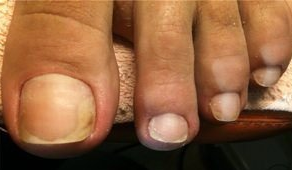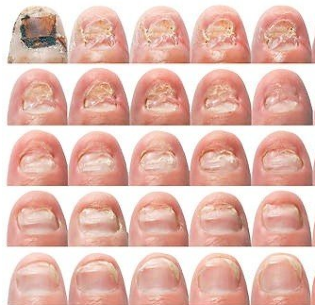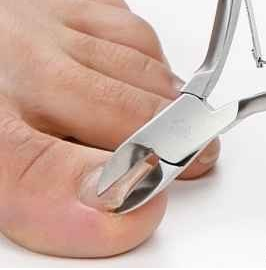Almost every third person occurs in the nail fungus in the feet. The disease bears the name of onychomycosis and is causing separation and collapse of the nail. Onihomikozy can happen at any age and require prompt appropriate therapy under the guidance of a specialist.

What is onychomycosis?
Onychomycosis - fungal infection of a nail. The disease can be caused by fungi-dermatophytes or with microsporia. Fungi adversely affect the manufacturing base nail – keratin and, gradually eating, causing deformation changes.
There are the following types of onychomycosis:
- Normotroficheskie. Change nail colors, the appearance of lines and blemishes.
- Hypertrophic. Not only is the change of color, but also easy to deformation. Often the nail is deformed from the brink.
- Onicholocheskiy. Nail is destroyed, coma and rejected.
The yeast infection can cause deformation of nails on free margin, with the sides and the area of the back roller. With the development of the disease affects the entire nail plate.
Causes
Fungus in the toenails occurs not only due to the reduction of immunity. About 70% of the people who have been infected by the patient, a man, and often is a relative. Small flakes of skin with a stand within the objects of domestic use, and, coming in contact with healthy tissues, nails or skin, is known to infect the healthy person.
Most often the infection occurs through:
- Washcloths.
- Sponge.
- Towels.
- Mats.
- Shoes.
- Manicure toilet.

When you visit the beach, a sauna, and baths without slippers there is a high risk of infection of the fungus in the feet. In high humidity and temperature contamination happens a lot more often.
Especially careful you have to be in public areas where people walk barefoot. Fungus resistant, such as high and low temperatures, and on the beach with the sand retain its vitality in a few months.
The slightest wound and abrasion of the foot during contact with contaminated objects can cause onychomycosis. It's not worth to continue wearing shoes for other people, even if the external manifestations of the fungus have not been identified. They can be carriers of pathogenic microflora, and with a lot of immunity the disease has not manifested.
Signs
The initial stage of the fungus in the feet is manifested by dryness and peeling. In that time the person may not notice visual changes of the slab, but is tormented by itching and burning sensation in the area of the fingers. Gradually increase perspiration, and in rare cases, bubbles appear and calluses. As well as integration in fungi on the nails starts to change color, become brittle and cracked.
Nail under the microscope contains a mixture of and vacuum. The feet begin to smell bad, and the general symptomatology is enhanced.
In severe cases increases the temperature of the body and is a significant pain syndrome, which gives the walk. As shown by nail fungus on the feet, and what changes are typical for this largely depends on the type and strength of the human immune system.
Fungi dermatophytes occurring yellow longitudinal stripes, yeast - causing detachment of the nail and yellowing. Molds fungi – the ratio of the surface of the defeat of the nail, which can be yellow, brown, blue or green color.
Description of disease with different species of fungi is different, but has common symptoms.
These relate to:
- The color change of the nail plates.
- Itching and burning of the skin of the toes.
- Stripes and spots under the nails.
- The collapse and destruction of the nail on each side.
- Redness of the skin around the nails.
- Hyperkeratosis (thickening of the nail).
Starts the disease with the defeat nail little finger or the thumb on his feet, after which the infection all the plates. Occurs cornification rivet, compressed and crumbles. A yeast infection usually surprise people, adults and the elderly, and children is extremely rare.

Treatment the doctor, dermatologist or mycologist. For the exact diagnosis is not enough visual inspection and required laboratory research. For this purpose a small part of a nail sent to microscopic examination. During the detection of the fungus designate the kind with the seed in a nourishing environment.
Despite the fact that most of the diseases of the nail plates in adults is a fungus, there are many pathological conditions with similar symptoms. Defeat of the nail fungus can cause similar symptoms but requires different treatment. Is panaris, or acute purulent inflammation of the fingers, it requires surgical treatment.
From the treatment of fungus of the nails?
You don't have to hope that the fungus is not yourself. The longer a person suffers from this disease, the harder it will be to further treatment.
Duration of treatment and the choice of drugs depends on:
- The stage of the disease.
- With the extent of the damage nail.
- Clinical form of the disease.
The initial stages of the nail fungus of the foot, and require the use of local medicines, which may be in the form:
- Solutions.
- Ointments of mildew.
- Creams.
- Varnishes.
Apply to medicines for external use, preferably after keratolytic treatment of the nail.
Before each application process medication must:
- To soap-soda loading. In a small bowl add a tablespoon of baking soda and the salt and 50 g of the economic soap. Keep the leg your feet in the solution for about 15 minutes.
- To treat the damaged claw. With a special rasps the upper layer of nail gnawing away for the drug better soaked.
- To apply the medicine. The drug is applied on dry clean nails and the skin around them.
When you use solutions, ointments and creams drug is applied 2-3 times a day, and varnishes – 2 times a week. The course of treatment set by the doctor, depending on the existing damage.
If the surface of the nail is completely overwhelmed and topical medications have positive effects, it is recommended the combined with systemic antimicotica.
System drugs have a long list of contraindications and should be prescribed by the attending physician. Most of them are prohibited to take during pregnancy and lactation, children's age and in chronic diseases of the liver and kidney.

In severe cases, under-nail fungus you may need removal of the nail. Process you can spend as surgical, and keratolytic containing salicylic acid and urea.
Removal of the nail keratolytic patch is distinguished for convenience. After steaming foot patch gently applied to the affected nail plate and sealed adhesive tape. In a few days the patch is removed, cut the affected areas plate, is applied to one of the antifungal drugs. The process is run several times.
During the treatment, it is important to eliminate the risk of repetition of self-contamination. To do this all the shoes is treated with a special disinfectant solution. From the socks they were wearing before the start of treatment, it is better to get rid. In the future, each month shall be re-edited shoes, and clothes. If you opt out of this process, through a short period of time the fungus may appear again.
The symptoms and treatment of the fungus is fully personalized and at the first sign of this disease should contact with your doctor. Only he can put an accurate diagnosis and get effective medication. In the opposite case, the fungus begins to spread to other nails and make them destroy.































